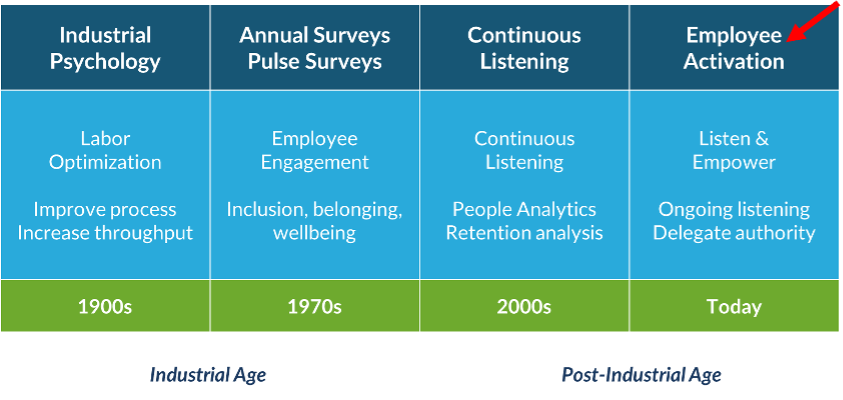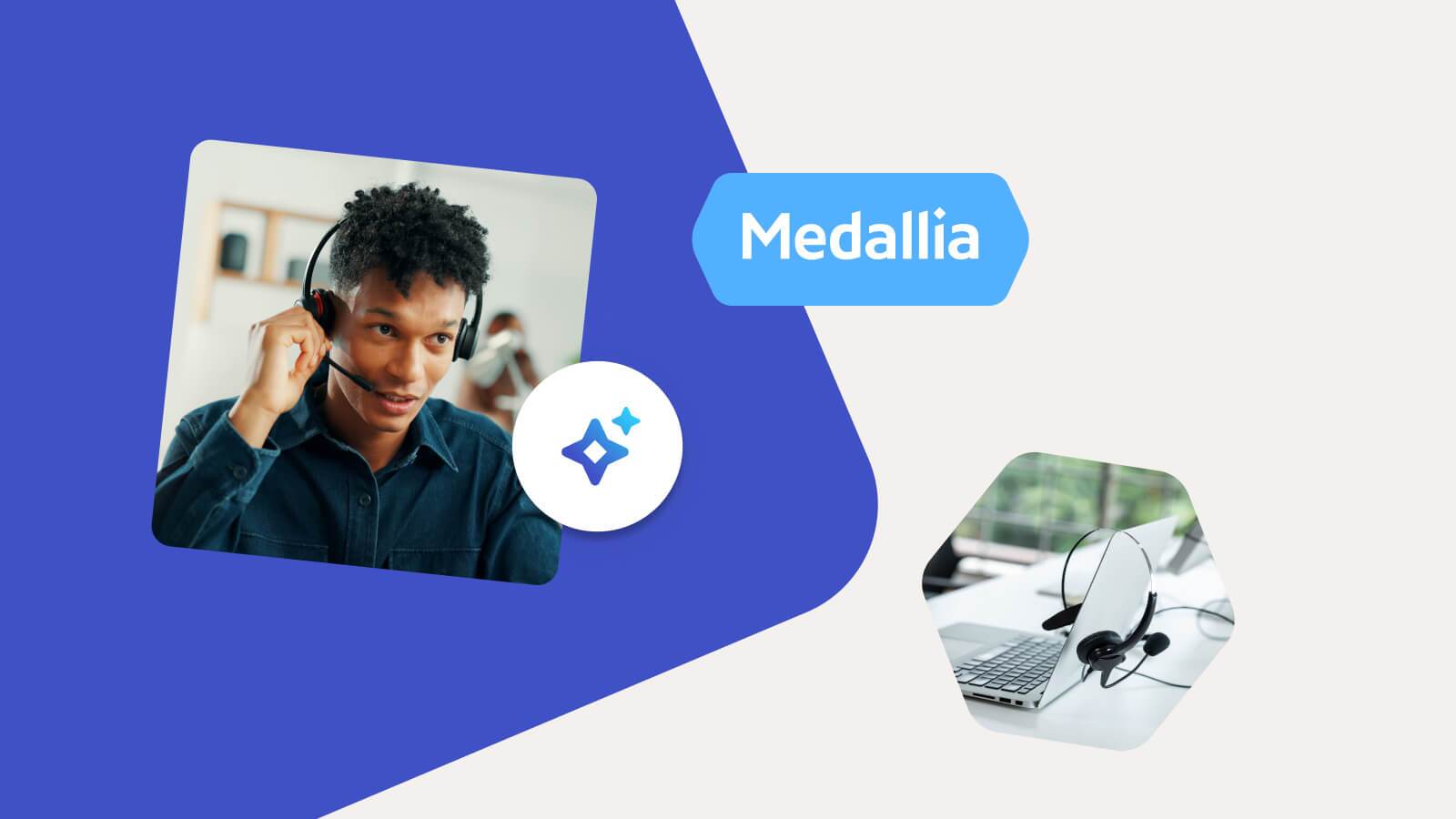Employee Activation: Transforming Your Business Through Frontline Innovation
June 5, 2024
Employee Experience
Find out what employee activation is, how it’s the next step in the evolution of employee listening and employee experience programs, and how to achieve employee activation through an anytime listening program.
Organizations are experiencing an era of transformation. With AI expanding into every market, increased pressure to boost productivity, and competition as an ever-driving force, companies must innovate faster than ever before.
Simultaneously, employees want to have a voice in business decisions — from defining strategy to inventing products and services and designing new ways of working. In fact, the 2023 Edelman Trust Barometer special report on trust at work found that 80% of employees would choose a job based on the opportunity to achieve personal empowerment.
These shifting employee expectations and business needs are converging to form a unique opportunity for organizations — to better leverage ideas, feedback, and innovation directly from their people, powering business change.
Micro Changes for Macro Results
Transformation can mean large changes for a business — moving into a new industry, undergoing a rebrand, or introducing an entirely new product. But it can also include many smaller changes that add up to a substantial impact for employees, customers, and the company at large.
These could look like:
- Improving the fine print for promotions or policies that confuse or disappoint customers
- Fixing a business process that takes hours of employees’ time every day
- Moving the placement of cabinets in hospital rooms to enable nurses to better tend to patients
The ideas that spark these smaller changes don’t come out of nowhere. They usually start with a business problem that someone identifies — likely an employee directly experiencing that problem in their day-to-day workflows. For example, a U.S. bank turned off background music in its branches as a cost saving measure. As it turned out, once the atmosphere became quiet, it made customers hesitant to share confidential information, impacting both the customer experience and employees’ ability to do their job to best serve the customer.
Luckily, in this example, employees had access to an always-on survey so they could provide their feedback in real time. When managers saw that the topic “music” was trending in the comments they were receiving, they were able to dig deeper to discover how this seemingly small decision was having massive implications across the business. However, often organizations miss out on these types of insights from employees — especially if the decision maker is far removed from the frontlines and there isn’t an easy way for employees to surface and solve the problems they encounter in their day to day. When that’s the case, these decisions can inadvertently impact productivity, the employee and customer experience, and, ultimately, company performance.
The Process and Potential of Employee Activation
So how can organizations effectively uncover these business problems, activate ideas and solutions from employees, and take action to effectively implement them — empowering employees to shape business strategies, customer solutions, and productivity?
This is where employee activation comes in. We introduced this concept at Experience ’24 as a critical shift and the next step for employee listening today.
What is employee activation? Employee activation has two parts:
- Empowering employees across the organization to share obstacles, feedback, and ideas in the flow of work.
- Empowering stakeholders across the organization to garner meaningful insights and take action where it matters — to influence the business in a positive way.

Source: Medallia and The Josh Bersin Company, 2024
These two parts facilitate one another. When employees are empowered to share ideas and have a means to do so, this drives insights and action. And when the company continuously and transparently incorporates employee ideas and feedback into business decisions, the workforce becomes more empowered to share.
A Shift from Traditional Listening: The Evolution of Employee Experience
Employee activation is distinct from traditional employee listening in that it creates a true dialogue between the organization and the business — with an impact that goes beyond employee experience. Rather than focusing on employee engagement surveys, benchmarking, and action-planning at a leadership level, employee activation focuses on employee-centered feedback, insights, and democratized action, incorporated into existing business routines.

Source: The Josh Bersin Company, 2024
Crowdsourcing is one way to power employee activation. T-Mobile uses Ideas, Medallia’s crowdsourcing platform to power the company’s “T-Action” program, which encourages employees to submit ideas, vote on their peers’ suggestions, and comment to provide further input. Some of the initiatives that have been proposed include a pitch about the best 5G and putting signs in stores by the beach in Hawaii advising customers, “No shirt, no shoes, no service” — an idea that would never have occurred to the company’s corporate office but is critical to providing a better customer experience in these locations. The best crowdsourcing programs are centered around what employees feel is important to share, rather than what the company or leadership team wants to know, enabling frontline innovation in ways surveys can’t.
The Employee Activation Framework
Employee activation is not a single practice, but rather, a strategic shift toward employee empowerment that supports both employees and the business. Our Employee Activation Framework identifies and defines five key elements with 20 dimensions that encompass an effective employee activation strategy. These cover everything from how the activation strategy is managed to how the organization is listening and taking action, important aspects of company culture, and the role of technology.

Source: The Josh Bersin Company, 2024
For example, one organization may have a strong culture around employee feedback and sharing but is missing the data to garner insights and take impactful action. Another might be great at democratizing action-taking but is lacking a defined strategy that ties back to business outcomes. When making the shift to employee activation, it’s important to consider both the tactical methods to activate employee insights and the underlying company characteristics that enable the strategy overall.
The Influence of AI and Technology
Technology is one of the five elements of the Employee Activation Framework, as it provides the infrastructure underlying an effective employee activation program. AI and other technological advancements have begun to shape listening in a big way — from creating more diverse and accessible channels for providing feedback and embedding these opportunities into employees’ workflows to democratizing insights in real-time and nudging the right actions.
AI has taken listening to a new level. Solutions like Medallia’s Text Analytics use AI to analyze feedback, derive insights, and make personalized recommendations for action — altogether powering employee activation. Furthermore, the use of AI assistants has unlocked the ability for a true dialogue between employees and the company that is infinitely scalable because employees get to ask the company questions, and those questions can inform actions.
Getting Started with Employee Activation
Transforming the organization from the bottom up takes time and effort but is so worthwhile, given the potential to move your company towards better customer and employee experiences, stronger financial outcomes, and more innovation and productivity.
Employee activation isn’t a shift that happens overnight. Starting with a single business problem can be helpful:
- Identify an important business problem
- Listen to the frontlines to understand what’s at the root of the problem
- Analyze responses and ideas to garner insights
- Empower the right stakeholders to take action based on these insights
- Measure success and continuously iterate
Organizations that prioritize employee activation are better positioned to land at the head of the employee experience maturity curve, and to enable true employee activation, companies must grant employees the authority to share what’s on their minds at all times using always-on, anytime listening. Check out Medallia’s The Definitive Guide to Anytime Listening to for step-by-step insights into building out an effective anytime listening program.









